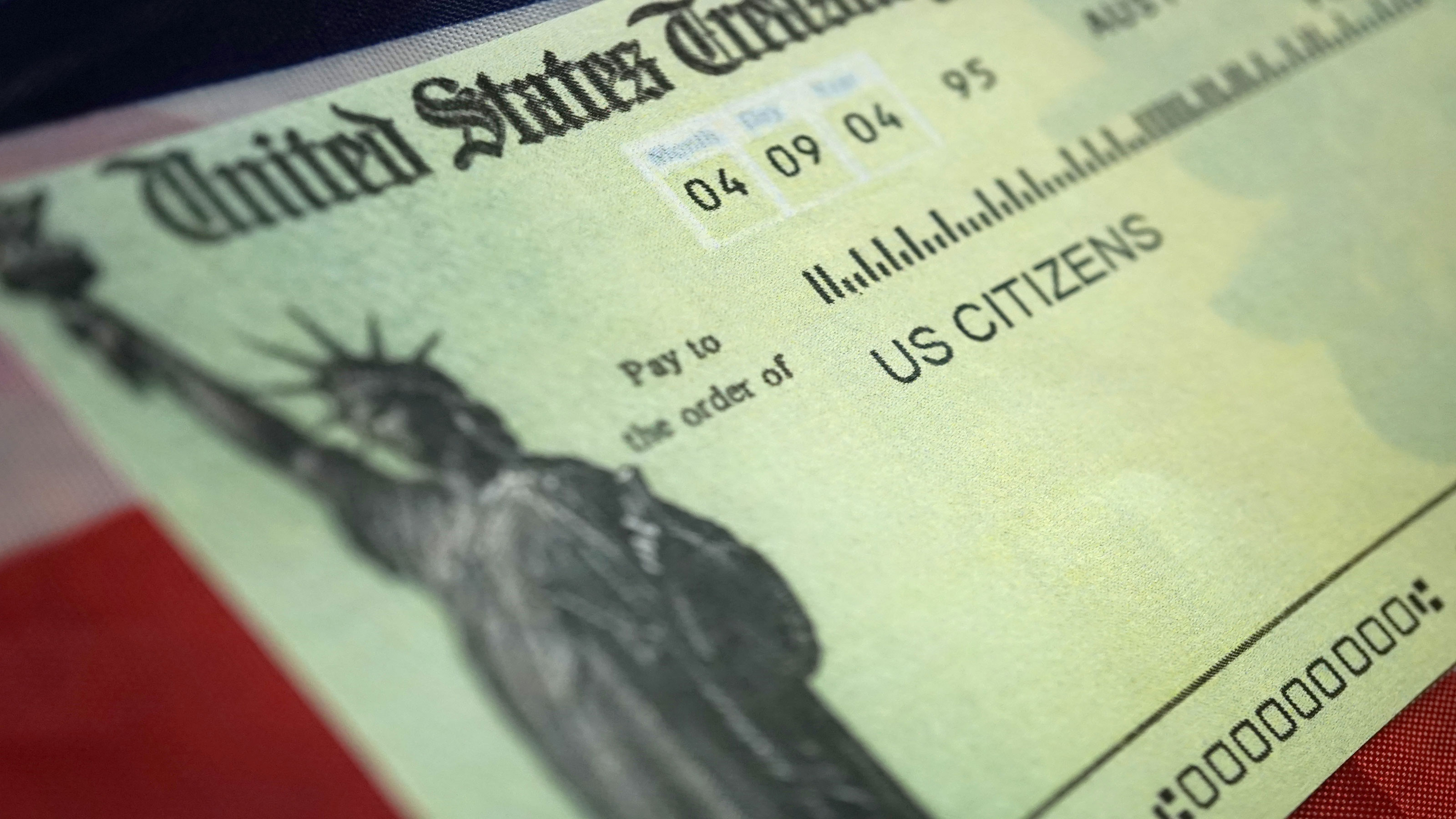Biden Calls for $1,400 Third Stimulus Checks as Part of $1.9 Trillion Relief Package
Under President Biden's plan for a third stimulus check, families with older dependents would benefit, but payments could be "targeted" to the most in need.


A third stimulus check of $1,400 – that's what President Joe Biden is calling for in his $1.9 economic stimulus plan. This, when combined with the $600 second-round payments authorized last month, would bring the total post-CARES Act stimulus check relief to $2,000 per eligible person. (The CARES Act, which was enacted in March, provided first-round stimulus payments of $1,200.)
President Biden also wants to expand eligibility for the additional payments that, for the first two stimulus checks, only went to families with dependent children under age 17. Under the president's plan, the additional payments would also go to all dependents, regardless of age. This would include children over 16 years of age, college students age 23 or younger, and elderly parents living with their adult children. Under Biden's plan, Americans who can claim these people as dependents on their tax return would get an additional $1,400 per dependent tacked on to their third stimulus check.
A plan summary also states the third-round payments would also go to "all mixed status households." That presumably means that if one spouse qualifies for a payment but the other one doesn't (e.g., because he or she doesn't have a Social Security number), then the family would still be eligible for payments for qualifying members of the household.
From just $107.88 $24.99 for Kiplinger Personal Finance
Be a smarter, better informed investor.

Sign up for Kiplinger’s Free Newsletters
Profit and prosper with the best of expert advice on investing, taxes, retirement, personal finance and more - straight to your e-mail.
Profit and prosper with the best of expert advice - straight to your e-mail.
The summary also stated that the Treasury Department would have the "flexibility and resources it needs to deliver stimulus checks to the families that need them most." That includes eligible families that still haven't received $1,200 payments under the CARES Act.
"Targeted" Third Stimulus Checks?
Biden may also "target" third-round stimulus checks to Americans with lower incomes. In December, the House of Representatives passed the CASH Act, which also would have provided a third round of $1,400 stimulus checks and expand the additional payment to all dependents. That bill, however, never got a vote in the Senate and died at the end of the previous Congressional term. The main objection for Senate Republicans was that CASH Act stimulus checks would have been sent to wealthy people who didn't need the money. Since then, a group of moderate Senate Republicans offered an alternative plan that would also have sent stimulus check only to people with lower incomes. Even some Democrats are pushing for payments to fewer Americans. For instance, Sen. Joe Manchin (D-W.Va.) suggested that he won't support a third round of stimulus checks unless payments are "targeted" and only sent to Americans who actually need them.
For first- and second-round payments, the total amount was reduced for people at certain income levels. Your payments were gradually reduced to zero if you're single with an adjusted gross income (AGI) above $75,000. If you're married (or a surviving spouse) and file a joint tax return, the amount of your first two stimulus checks dropped if your AGI surpassed $150,000. If you claim the head-of-household filing status on your tax return, your payments were reduced if your AGI topped $112,500. First- and second-round stimulus payments were reduced at a rate of $1 for every $20 over the applicable AGI threshold.
However, if President Biden wants to adjust the phase-out rules to make third-round stimulus checks more targeted, there are three easy ways to do this. First, create a bright line cut off for stimulus payments (i.e., no phase-out). In other words, if your income is below the cut-off threshold, you get the full amount. If your income is above the threshold, you get nothing. Second, the phase-out threshold amounts could be lowered. For instance, instead of having payments for married couples drop if their AGI is over $150,000, have the reduction begin with an AGI exceeding $100,000. The third way is to adjust the phase-out rate. For example, changing the rate to, say, $1 for every $10 over the threshold would reduce payments for people with higher incomes to zero faster.
The most likely targeting option for the Biden plan is to lower the threshold amounts (option #2 above). The tables below illustrate how this would change who gets a third stimulus check under the president's plan. The first set of tables show how much you would get – based on your filing status, AGI, and number of dependents – under Biden's plan (i.e., $1,400 base amount; $1,400 per dependent) if the same threshold amounts and phase-out rate used for the first two stimulus payments is applied (see above).
SINGLE PEOPLE ($75,000 THRESHOLD)
| Row 0 - Cell 0 | NUMBER OF DEPENDENTS IN THE FAMILY | |||||
| AGI | 0 | 1 | 2 | 3 | 4 | 5 |
| ≤ $75,000 | $1,400 | $2,800 | $4,200 | $5,600 | $7,000 | $8,400 |
| $100,000 | $150 | $1,550 | $2,950 | $4,350 | $5,750 | $7,150 |
| $125,000 | $0 | $300 | $1,700 | $3,100 | $4,500 | $5,900 |
| $150,000 | $0 | $0 | $450 | $1,850 | $3,250 | $4,650 |
| $175,000 | $0 | $0 | $0 | $600 | $2,000 | $3,400 |
| $200,000 | $0 | $0 | $0 | $0 | $750 | $2,150 |
| $225,000 | $0 | $0 | $0 | $0 | $0 | $900 |
| ≥ $250,000 | $0 | $0 | $0 | $0 | $0 | $0 |
--
HEAD-OF-HOUSEHOLD FILERS ($112,500 THRESHOLD)
| Row 0 - Cell 0 | NUMBER OF DEPENDENTS IN THE FAMILY | |||||
| AGI | 0 | 1 | 2 | 3 | 4 | 5 |
| ≤ $112,500 | $1,400 | $2,800 | $4,200 | $5,600 | $7,000 | $8,400 |
| $125,000 | $775 | $2,175 | $3,575 | $4,975 | $6,375 | $7,775 |
| $150,000 | $0 | $925 | $2,325 | $3,725 | $5,125 | $6,525 |
| $175,000 | $0 | $0 | $1,075 | $2,475 | $3,875 | $5,275 |
| $200,000 | $0 | $0 | $0 | $1,225 | $2,625 | $4,025 |
| $225,000 | $0 | $0 | $0 | $0 | $1,375 | $2,775 |
| $250,000 | $0 | $0 | $0 | $0 | $125 | $1,525 |
| $275,000 | $0 | $0 | $0 | $0 | $0 | $275 |
| ≥ $300,000 | $0 | $0 | $0 | $0 | $0 | $0 |
--
MARRIED COUPLES FILING A JOINT RETURN ($150,000 THRESHOLD)
| Row 0 - Cell 0 | NUMBER OF DEPENDENTS IN THE FAMILY | |||||
| AGI | 0 | 1 | 2 | 3 | 4 | 5 |
| ≤ $150,000 | $2,800 | $4,200 | $5,600 | $7,000 | $8,400 | $9,800 |
| $175,000 | $1,550 | $2,950 | $4,350 | $5,750 | $7,150 | $8,550 |
| $200,000 | $300 | $1,700 | $3,100 | $4,500 | $5,900 | $7,300 |
| $225,000 | $0 | $450 | $1,850 | $3,250 | $4,650 | $6,050 |
| $250,000 | $0 | $0 | $600 | $2,000 | $3,400 | $4,800 |
| $275,000 | $0 | $0 | $0 | $750 | $2,150 | $3,550 |
| $300,000 | $0 | $0 | $0 | $0 | $900 | $2,300 |
| $325,000 | $0 | $0 | $0 | $0 | $0 | $1,050 |
| ≥ $350,000 | $0 | $0 | $0 | $0 | $0 | $0 |
--
However, if the phase-out thresholds are lowered to $50,000 (singles), $75,000 (head-of-household filers) and $100,000 (joint filers), the next set of tables show how large your third stimulus check would be – based on your filing status, AGI, and number of dependents – under Biden's plan for payments with a $1,400 base amount plus an additional $1,400 per dependent (assuming the same phase-out rate used for first- and second-round payments is applied).
SINGLE PEOPLE ($50,000 THRESHOLD)
| Row 0 - Cell 0 | NUMBER OF DEPENDENTS IN THE FAMILY | |||||
| AGI | 0 | 1 | 2 | 3 | 4 | 5 |
| ≤ $50,000 | $1,400 | $2,800 | $4,200 | $5,600 | $7,000 | $8,400 |
| $75,000 | $150 | $1,550 | $2,950 | $4,350 | $5,750 | $7,150 |
| $100,000 | $0 | $300 | $1,700 | $3,100 | $4,500 | $5,900 |
| $125,000 | $0 | $0 | $450 | $1,850 | $3,250 | $4,650 |
| $150,000 | $0 | $0 | $0 | $600 | $2,000 | $3,400 |
| $175,000 | $0 | $0 | $0 | $0 | $750 | $2,150 |
| $200,000 | $0 | $0 | $0 | $0 | $0 | $900 |
| ≥ $225,000 | $0 | $0 | $0 | $0 | $0 | $0 |
--
HEAD-OF-HOUSEHOLD FILERS ($75,000 THRESHOLD)
| Row 0 - Cell 0 | NUMBER OF DEPENDENTS IN THE FAMILY | |||||
| AGI | 0 | 1 | 2 | 3 | 4 | 5 |
| ≤ $75,000 | $1,400 | $2,800 | $4,200 | $5,600 | $7,000 | $8,400 |
| $100,000 | $150 | $1,550 | $2,950 | $4,350 | $5,750 | $7,150 |
| $125,000 | $0 | $300 | $1,700 | $3,100 | $4,500 | $5,900 |
| $150,000 | $0 | $0 | $450 | $1,850 | $3,250 | $4,650 |
| $175,000 | $0 | $0 | $0 | $600 | $2,000 | $3,400 |
| $200,000 | $0 | $0 | $0 | $0 | $750 | $2,150 |
| $225,000 | $0 | $0 | $0 | $0 | $0 | $900 |
| ≥ $250,000 | $0 | $0 | $0 | $0 | $0 | $0 |
--
MARRIED COUPLES FILING A JOINT RETURN ($100,000 THRESHOLD)
| Row 0 - Cell 0 | NUMBER OF DEPENDENTS IN THE FAMILY | |||||
| AGI | 0 | 1 | 2 | 3 | 4 | 5 |
| ≤ $100,000 | $2,800 | $4,200 | $5,600 | $7,000 | $8,400 | $9,800 |
| $125,000 | $1,550 | $2,950 | $4,350 | $5,750 | $7,150 | $8,550 |
| $150,000 | $0 | $1,700 | $3,100 | $4,500 | $5,900 | $7,300 |
| $175,000 | $0 | $450 | $1,850 | $3,250 | $4,650 | $6,050 |
| $200,000 | $0 | $0 | $600 | $2,000 | $3,400 | $4,800 |
| $225,000 | $0 | $0 | $0 | $750 | $2,150 | $3,550 |
| $250,000 | $0 | $0 | $0 | $0 | $900 | $2,300 |
| $275,000 | $0 | $0 | $0 | $0 | $0 | $1,050 |
| ≥ $300,000 | $0 | $0 | $0 | $0 | $0 | $0 |
Using these tables, you can see how this affects people with higher incomes. For example, a married couple with two child and an AGI of $200,000 would get a $3,100 stimulus check if the same phase-out threshold amounts used for the first two stimulus payments is applied. But if the lower threshold amounts are used, that same couple would only get $600.
Profit and prosper with the best of Kiplinger's advice on investing, taxes, retirement, personal finance and much more. Delivered daily. Enter your email in the box and click Sign Me Up.
Rocky Mengle was a Senior Tax Editor for Kiplinger from October 2018 to January 2023 with more than 20 years of experience covering federal and state tax developments. Before coming to Kiplinger, Rocky worked for Wolters Kluwer Tax & Accounting, and Kleinrock Publishing, where he provided breaking news and guidance for CPAs, tax attorneys, and other tax professionals. He has also been quoted as an expert by USA Today, Forbes, U.S. News & World Report, Reuters, Accounting Today, and other media outlets. Rocky holds a law degree from the University of Connecticut and a B.A. in History from Salisbury University.
-
 Amazon Surge Sends S&P 500, Nasdaq Higher to Start November: Stock Market Today
Amazon Surge Sends S&P 500, Nasdaq Higher to Start November: Stock Market TodayAmazon inked a $38 billion cloud deal with OpenAI, which sent the stock to the top of the Dow Jones on Monday.
-
 If You'd Put $1,000 Into Home Depot Stock 20 Years Ago, Here's What You'd Have Today
If You'd Put $1,000 Into Home Depot Stock 20 Years Ago, Here's What You'd Have TodayHome Depot stock has been a buy-and-hold banger for truly long-term investors.
-
 The Original Property Tax Hack: Avoiding The ‘Window Tax’
The Original Property Tax Hack: Avoiding The ‘Window Tax’Property Taxes Here’s how homeowners can challenge their home assessment and potentially reduce their property taxes — with a little lesson from history.
-
 Social Security Tax Limit Rises Again: Who Pays More in 2026?
Social Security Tax Limit Rises Again: Who Pays More in 2026?Payroll Taxes The Social Security Administration has announced significant changes affecting millions as we approach a new year.
-
 Three Critical Tax Changes Could Boost Your Paycheck in 2026
Three Critical Tax Changes Could Boost Your Paycheck in 2026Tax Tips The IRS predicts these tax breaks may change take-home pay in 2026. Will you get over $1,000 in tax savings?
-
 The Rubber Duck Rule of Retirement Tax Planning
The Rubber Duck Rule of Retirement Tax PlanningRetirement Taxes How can you identify gaps and hidden assumptions in your tax plan for retirement? The solution may be stranger than you think.
-
 RMDs, Roth, and SS: Test Your Knowledge of Retirement Tax Rules
RMDs, Roth, and SS: Test Your Knowledge of Retirement Tax RulesQuiz Don't let the IRS catch you off guard. Take our quiz to reveal common retirement tax rules that could save (or cost) you thousands.
-
 What’s the New 2026 Estate Tax Exemption Amount?
What’s the New 2026 Estate Tax Exemption Amount?Estate Tax The IRS just increased the exemption as we enter into a promising tax year for estates and inheritances.
-
 IRS Updates 2026 Tax Deduction for People Age 65 and Older
IRS Updates 2026 Tax Deduction for People Age 65 and OlderTax Changes Adjustments to the extra standard deduction can impact the tax bills of millions of older adults. Here are some new amounts to know for 2026.
-
 IRS Reveals New 2026 Child Tax Credit and other Family Credit Amounts
IRS Reveals New 2026 Child Tax Credit and other Family Credit AmountsTax Credits Key family tax breaks are higher for 2026, including the Earned Income Tax Credit and the Adoption Credit. Here's what they're worth.
